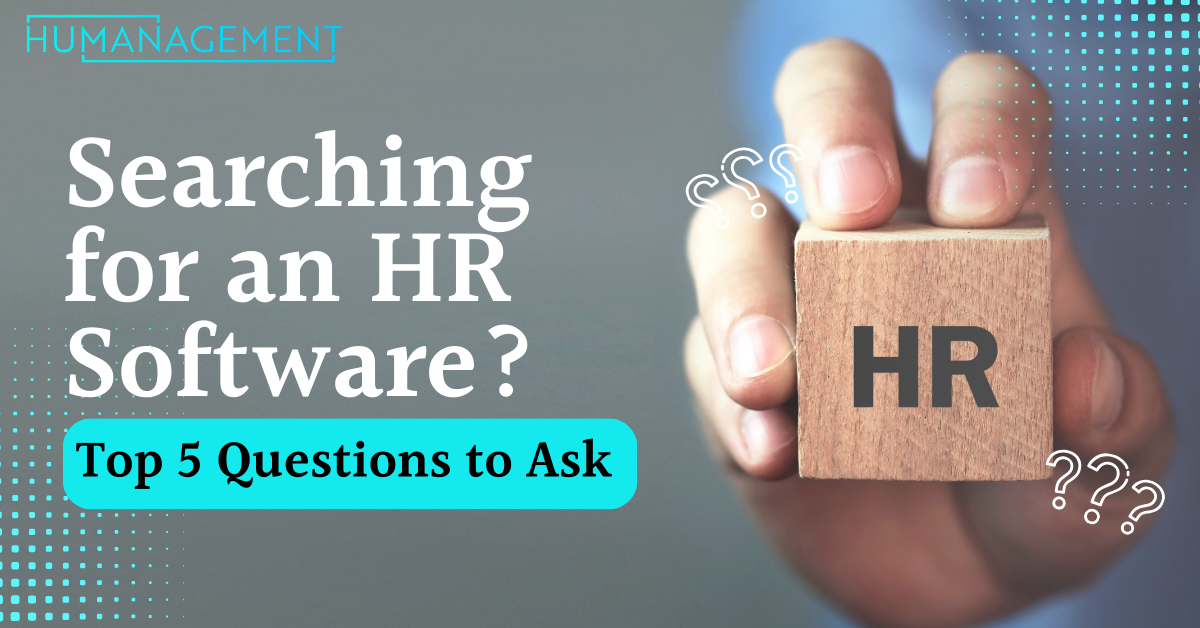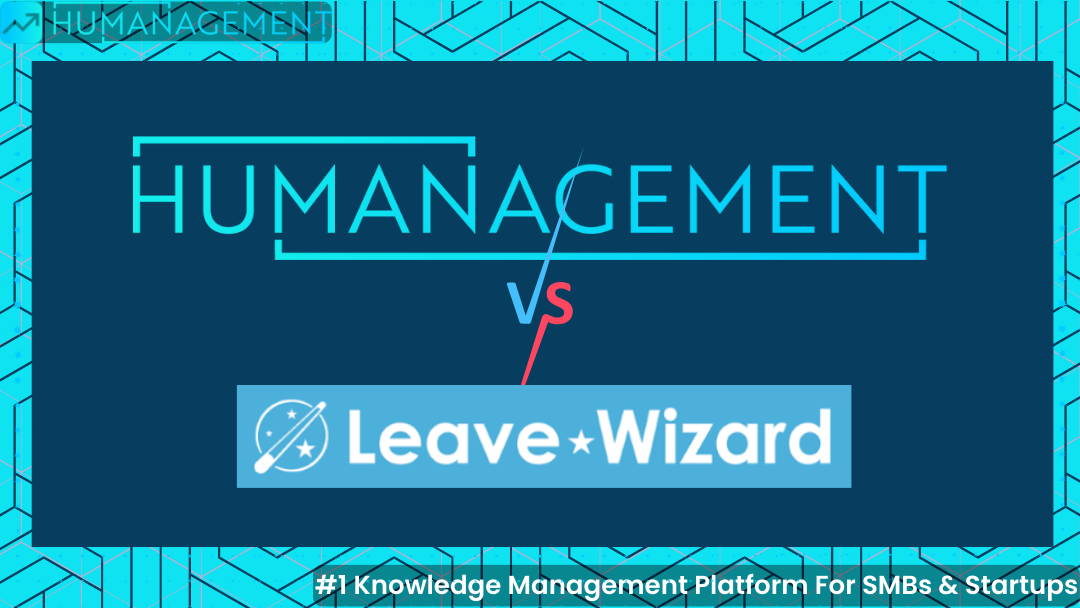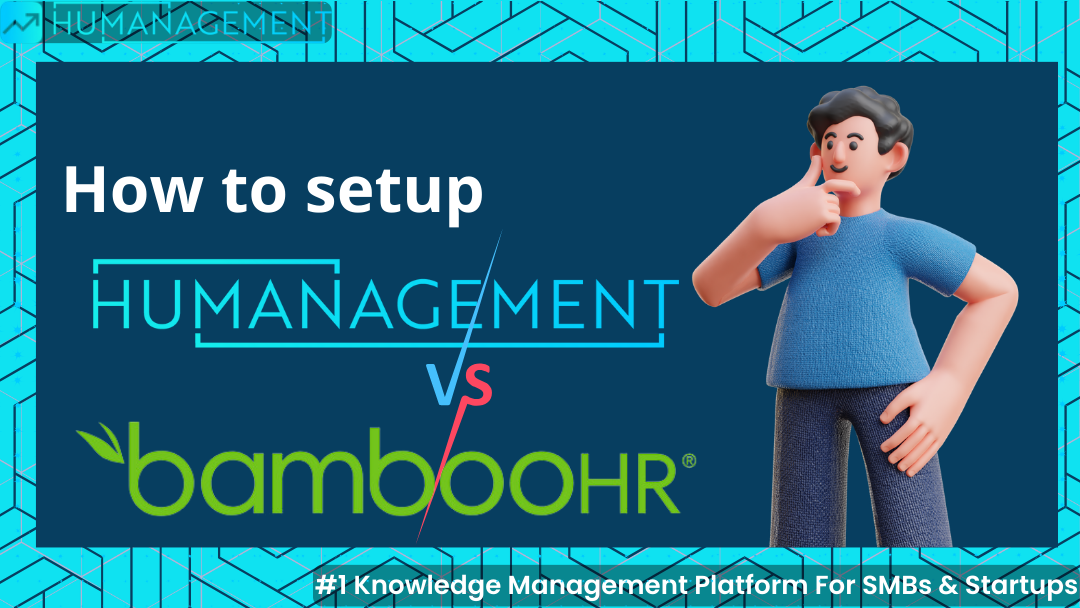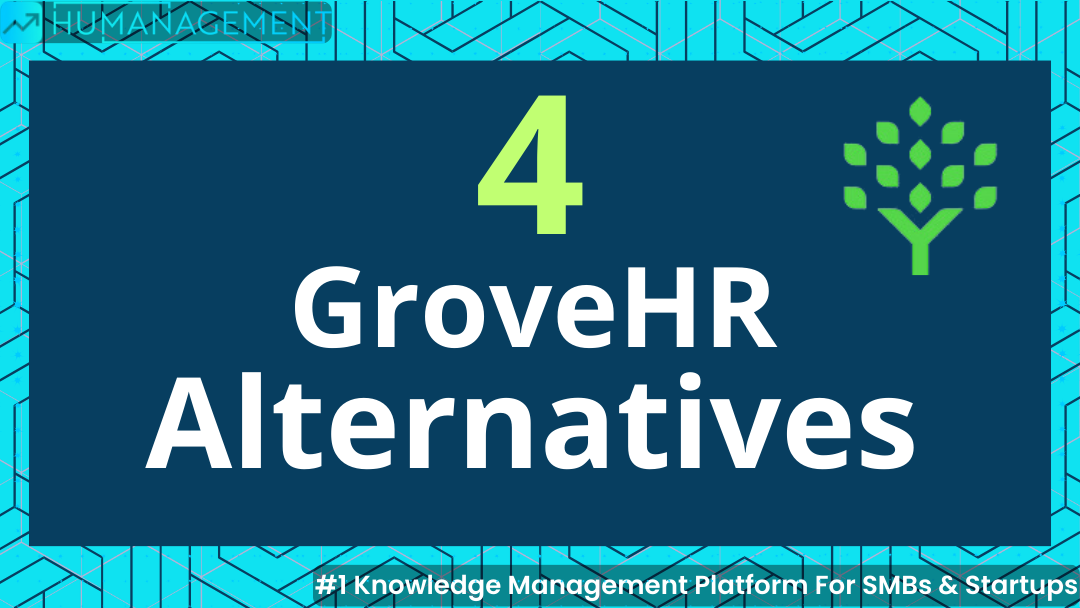
From onboarding new hires to providing mental health support and managing sick absences, businesses have many HR responsibilities. To make HR processes as efficient as possible and to maintain compliance effectively, you should be investing in an HR software system. When searching for HR software, consider answering these five questions before choosing one.
HR software systems simplify HR processes and boost productivity by securely storing people’s data in a single location. Managers, staff, and HR team members can easily manage absences, review performance, track pay and benefits, and track progress in learning and development.
Choosing the right HR software for your company can be difficult. The size of your organization and the various types of HR software systems on the market are just two of many factors to consider.
Here, we share the five key questions you and other managers in your organization should be asking in order to find the HR software system that works for you.
To identify the best HR software system for your organization, create a list of desired features. Research the various options available and select the system best suited to your needs.
A Human Resource Information System (HRIS) is a database of employee information. Also known as a Human Resource Management System (HRMS), the system streamlines HR functions and processes, increasing data accuracy. Additionally, it allows employees to access, update, and manage their own data through employee self-service, eliminating the requirement of retyping information.
Human Capital Management (HCM), also referred to as HRIS (Human Resource Information System) or HRMS (Human Resource Management System), is an HR solution that assists with payroll, learning, recruitment, and onboarding processes.
Be sure to understand the distinction between software as a service (SaaS) and on-premises software. SaaS HR software is cloud-based and accessible over the internet.
On-premises software, however, is installed on the customer’s servers and downloaded to a predetermined number of computers based on license fees paid. This software must be updated and maintained by users, whereas SaaS updates are automated.
SaaS solutions are usually considered the best option for HR since they make information easy to access and update.
Determine the goals you want to achieve with an HR system and the expected ROI. Consider factors such as increased productivity, reduced staff turnover, and time saved on administrative tasks. Research HR providers and compare the cost of their systems, as well as the cost of implementation, to the potential ROI.
To get a good understanding of HR software, view demos to evaluate the user experience and discover how well it supports your employer’s brand.
Test a demo to ensure that the HR system is suitable for your business and user-friendly. Complicated HR systems can lead to employee disengagement and a decline in their efficacy. Ensure that employees are updated with their information to reap the most benefit from the HR system.
Choose an HR system that is easy to use with minimal training and guidance. Additionally, consider if it is optimized for mobile use and which features are accessible.
Investigate how easily the HR system can integrate with other tools used to track expenses and manage employee benefits. Integration enables quick access to HCM solutions from your system with one API and a single sign-on.
All stakeholders, from the CEO to IT, require different features from an HR system. The CEO desires up-to-date data on employee numbers, performance, talent shortages, and retention challenges. Employees need access to and the ability to update their personal employment information, as well as request vacation, view e-pay slips, and seek out online training, all from any browser and device. IT, on the other hand, prefers a centralized, browser-based HR system that is straightforward to manage.
Ask yourself and senior leaders what they want from a future HR system. Consider the size of your organization now and in the future—are you growing and likely to hire more people? Doing this will help you find an HR system that meets your long-term requirements.
If your organization belongs to a group, check if an HR system can accommodate the different entities, be available in various languages, and be compatible with payroll software used abroad. Also, is it able to observe the legal regulations of different countries? If these needs are likely to arise, an HR software system that meets the specifications could be an excellent choice in the long run.


Managing employee leave requests and time off can be a hassle for HR departments and small business owners. Thankfully, there are several software solutions that can help streamline the process. Two popular options are Humanagement and LeaveWizard. But in this article, we’ll take a closer look at these two software’s and compare their features, usability, pricing, and customer support.
LeaveWizard is software that helps companies manage employee leave and absences. It allows employees to request leave and managers to approve or deny requests, track holiday allowances, handle shift work, TOIL, overtime, and work from home. LeaveWizard also allows companies to tailor the experience to their organizational structure and personalize their workflows to suit their teams.
Additionally, it offers easy reporting, which allows companies to spot patterns of absence or annual leave that might affect the business and report against external indicators. It also has the capability of managing a variety of work patterns, different leave years, overtime, and time off in lieu (TOIL), plus several carryover strategies.
Humanagement is a comprehensive employee management software that helps CEOs, executives, and HR managers manage both their businesses and employees effectively. The software aims to make staff meetings and business organizations easier by providing an easy-to-use interface that’s clean, intuitive, and appealing.
It has a fully functional and customizable time tracking and leave request feature to help both managers and employees track and approve their PTO requests. It allows companies to keep track of policy management, compliance, and staff training, which can be done on autopilot. The software also helps companies save time and stress by providing fully automated functions for creating and storing video policies, compliance audit logs, tracking productivity and business analytics, time sheets, and paid time off. It also allows for integration with other software via Zapier, clocking in and out, assigning PTO allocations, and recording geolocation data reporting.
Without a leave management system, navigating the maze of leave administration is a difficult task. Your odds of surviving are quite slim if all you have are traditional technologies like paper forms, emails, and Excel spreadsheets. Disasters include a shortage of resources, incorrect payroll processing, and legal difficulties that can be brought on by even little errors.
Even the often-used Google forms are not effective enough to address certain major issues with leave management. All these inadequate tools only serve to reduce the effectiveness and productivity of your staff.
What use are your leave management software’s if too much manual work is required for them to work properly? These outdated techniques produce distorted data that is meaningless. Without human sorting, you cannot extract insight or identify issues from this jumbled mess. Even then, there are doubts about its accuracy. You need a strong leave management system to avoid administrative poisons, legal minefields, and payroll difficulties.
Now that we know how important having a leave management system in place is to your company or business, let’s discuss some key features any leave management system should have.
The process of requesting a leave of absence is automated by a leave management system (LMS), making it hassle-free for both management and employees. Your chosen solution should be capable of handling each step of the leave management process, including application, approval or rejection, filing leaves, monitoring leave balance, and analysis.
An All-in-one Dashboard
Employees should be able to view their leave balances while applying for leave. Supervisors and HR managers must have access to employee leave balances, holiday lists, and department schedules to better evaluate leave requests.
Customizable Leave Requests
Policies and procedures vary from one organization to another. A stiff leave management system with a “one size fits all’ approach may not meet your needs. Look for a product that lets you customize your leave to meet your organization’s policies.
Approval workflow
An effective leave management system should have a streamlined process for requests and approvals.
Seamless Integration
A leave management system should offer seamless integration with other HR software for payroll and timesheet management to save time and enable cross-functional reporting.
Leave Tracking., Overtime Calculation., Reporting & Statistics, Reporting/Analytics., Role-Based Permissions., and Sick Leave Tracking Time Off Requests. and vacation/leave tracking.
Leave tracking/approval process control, attendance tracking, data import/export, document management, employee database, employee management, employee onboarding, employee profiles, HR management, learning and development, onboarding, performance management, reporting and analytics, seamless integrations, and policy development.
With these many features, let us compare its usability and price to provide more insight into choosing the right management software for your organization.
Leavewizard currently has a rating of 4 out of 5, with its users complaining of the time it takes for the website to load. Although most users will tell you that they endure the wait for the nice dashboard, which provides an overview of leave requests and management,
Humanagement, on the other hand, has a 5 out of 5 rating on usability. It has a responsive and easy-to-navigate dashboard that allows users to easily manage their businesses and employees, relieving them of the stress and frustration of employee management.
LeaveWizard has no free plan. It is a subscription-based service, with prices starting at 8 euros per month for 10 employees.
As you can see, the features and capabilities of each software are distinct. LeaveWizard focuses primarily on employee leave and absence management, whereas Humanagement provides a more comprehensive employee management solution.
LeaveWizard can assist businesses in managing employee leave and absence, streamlining the process of booking vacation, and remaining in control of their employees’ absence.
Humanagement, on the other hand, can assist businesses in keeping track of policy management, compliance, and staff training, as well as tracking productivity and business analytics, time sheets, and paid time off. Consider your company’s needs and requirements, as well as the features offered by each software, to determine which one is the best fit for you.


BambooHR is an HR platform that enables growing businesses to automate, centralize, and connect their people’s data in a single location.
It provides a one-stop shop for managing employee data and gaining valuable insightsIdentify, hire, and onboard top talent. Simplify payroll, track hours, and capture benefits. And measure the employee experience and performance.
The next logical question given all of these features is: How long will it take me to setup the software application for my team?
Don’t doubt us when we say that setting up Bamboo HR completely can take up to 7-8 weeks. Let me take you through the process of setting up your Bamboo HR company account.
The majority of software available has simple signup procedures. Create an account, choose a plan, make a payment, and you’re done!
When you sign up for Bamboo HR, you supply all the relevant information, and an implementation professional is then assigned to you. Your designated implementation professional is tasked with assisting you with accurate document importation and walking you through the operation of the system to get you up and running. Additionally, you may anticipate at least two conversations with your implementation professional every week that will run between 30 minutes and an hour.
Whew! That’s a lot of work, and if your implementation specialist is swamped or your timeline is really constrained, it can take more than two months.
I thought I heard you ask whether there is any software that is much easier and can manage all of your company and HR needs.
Humanagement is the simple all-in-one software to easily manage both your business and employees. It has standard HR features plus policy and training management, tracking employee production with stats, and much more.
When you sign up with Humanagement, here’s what you’ll get:
Fully customizable Software with your company’s Logo and more
Employee and business performance statistics
Attendance management: clock-ins with data for payroll management.
Employee data management system
Time-off request
Purchase request
Knowledge base for courses and articles
Checklist templates, e.g., onboarding new hires
Your Company’s customized Organizational Chart
Responsibilities and assignments for task delegation
Integrations with apps you already work with.
In less than 50 minutes, you can have your Humanagement account up and running. Here’s how to do it by following these three simple steps:
On Humanagement, importing your company’s documents is one of the very first tasks. This can easily be done using the knowledge base features, which allow you to add documents in any format, videos, and links about your company. This is the knowledge bank of your company, where employees can access any information about your organization.
If you’ve not had the time to create or organize documents or policies for your company, Humanagement has a template resource in different categories to help you get started. The templates are international standards, and you only need a few adjustments to make them yours.
On Humanagement, importing your company’s statistics is one of the first tasks. By connecting Humanagement with any software you use to gather such data, it automatically updates itself without you having to do any work. Don’t have such statistics data? Humanagement offers a variety of templates to choose from. This can help you get started and can be modified in the future. This takes about 10–20 minutes. Read this Step-By-Step Guide to learn more.
By onboarding your employees in Humanagement, you’ll immediately have total control and accurate data on your employee and business performances at a glance. Humanagement makes it super easy to import your employees, even if there are one thousand of them. Bulk import your employees in under 20 minutes using the provided template as a guide.
That’s it! No paper work, no waiting for an integration specialist—zero time wasted. Setup takes under 50 minutes.
Humanagement has so many features to work with, and to fully use all the features, it can take up to about 4 weeks of constant use based on individual company requirements.
Humanagement also offers free setup support and 24/7 customer support to help you navigate through the software.
The question is, would you rather spend 6 weeks or 50 minutes setting up HR software?
Getting new HR software for the first time or switching from one program to another may be quite frustrating. Humanagement promises to fully reduce it and make the process much simpler for you.


In recent times, the use of human resources software has become quite popular, and just like any other software, HR software is built to help small businesses, companies, and organizations streamline, reduce, and automate their HR process and manage their employees.
The demand is high right now for HR software as businesses now focus more on actual productivity. There are numerous HR software programs available today, and by 2024, there will be over 200 programs with various functionalities to assist businesses with their HR processes. In this article, we will focus on some of the best GroveHR alternatives in 2023.
The most important question you might have is about to be answered.
Grove HR is an HR platform for small and medium-sized businesses. It provides a full employee lifecycle solution, from managing the employee directory to onboarding new hires, processing time off, attracting and tracking candidates, and much more. All from the software
Some of the top features of GroveHR include:
Attendance management.
Document Management.
Employee Self-Service Management
Mobile Support.
Here’s a thought: Most HR software already has these features, making GroveHR an average player in the HR software league.
Pros: Their friendly user interface and easy-to-use navigation are what users notice first. The recruitment feature enables users to be able to attract, track, and collaborate on the entire process without having to leave the app. Time off is also easily managed, as Grove HR has both a desktop and mobile app.
Cons: GroveHR can only be used by mostly startups and SME businesses, with not much consideration for when your business grows.
The truth is, your business needs more than these basic features to really streamline its HR processes, manage employees, and track productivity.
Now let’s take a look at some of the best alternatives to GroveHR.
Humanagement is a simple all-in-one software to easily manage both your business and employees. It has standard HR features plus policy and training management, tracking employee production with stats, and much more.
When you sign up with Humanagement, here’s what you’ll get:
Employee and business performance statistics
Attendance management
Employee data management system
Time-off request
Purchase request
Knowledge base for courses and articles
Checklist templates, e.g., onboarding new hires
Org chat
Responsibilities and assignments
Integrations with apps you already work with
Humanagement has everything that GroveHR has and more.
It is super easy to use, with a super friendly user interface. It is easily customizable, and you can even add your company logo and branding. Also, if you are looking to scale, you can do so easily with Humanagement, which allows you to add employees as your business expands.
Pros: Humanagement integrates with your other applications. This allows you to pull statistics, which helps you make important decisions at a glance. It also helps with GDPR compliance by generating a customized ORG chart upon account setup.
Cons: Most of its customers are eager for a mobile version of the application. It is currently on the software road map and will be available anytime now.
BrainyHR automates your processes, from onboarding to offboarding and everything in between, to connect your organization and team. Reduce time spent on routine HR work.
Some of the top features of BrainyHR include:
people management
Time off management
Performance review and
Reward programs
Surveys.
Pros: Most of its users find BrainyHR simple to use, with features suitable for mostly remote startups.
Cons: According to a recent survey, most of its users say the user experience (UX) is very poor, and even a tech-savvy individual will leave the software even more confused with a lot of questions.
LeaveWizard is cloud-based software that provides businesses with various features, including automated leave management, overtime tracking, and extensive reporting. Supervisors can automatically calculate entitlement or allowance, track individual leave years, and keep track of employees’ start and end dates.
Some of the features of LeaveWizard include:
Calendar Management
Leave Tracking
Overtime Calculation
Reporting and Statistics
Reporting/Analytics
Role-Based Permissions
Sick Leave Tracking
Time-off requests
Pros: Most of its users recommend the software because of its cost-effectiveness compared to other software on the market.
Cons: A lot of LeaveWizard customers complain of the time it takes for the web application to load, which is quite frustrating.
When it comes to an all-in-one HR solution, GroveHR is nothing special.
But,
If you need to manage your employees’ leave and time off in a cost-effective way, then get LeaveWizard.
If you need a reward program for your employees, BrainyHr is the way to go.
If you need all of the above, try Humanagement for free today.


Developing and retaining top talent is a never-ending challenge for organizations of all sizes and industries. It requires a combination of effective recruitment strategies, ongoing training and development opportunities, and a positive work environment that fosters engagement and employee satisfaction.
According to the Harvard Business Review, practically every company these days has some form of program designed to nurture its rising stars. With good reason, these high-achieving individuals can have an enormous impact on business results.
A study by the Society for Human Resource Management, “attracting and retaining top talent is one of the biggest challenges facing organizations today.” The study found that 71% of organizations surveyed identified recruiting and retaining top talent as a primary concern. The expectations of employees have shifted in recent years. In the past, job security and fair compensation were the primary factors considered when joining an organization. Now, employees not only want to feel invested in their work, but they also want to see that their employer shares their values and is committed to making a positive impact.
Feel valued and appreciated
Build a sense of community and trust among colleagues
Have opportunities for growth and development
Achieve a balance between work and personal life through flexible working arrangements.
If you asked, How can retain my top talents in the highly competitive job market? These Five (5) Strategies recommended by top performing HR managers is what you need.
One key element of effective talent management is a robust recruitment strategy that allows organizations to attract top talent in the first place. This can include leveraging social media and other digital platforms to reach a wider pool of candidates, offering competitive compensation packages, and providing clear and compelling information about the company culture and mission.
“People stay with companies when they see a clear path for advancement”
-HARVARD-
Once top talent has been recruited, organizations must focus on providing ongoing training and development opportunities that allow employees to grow and advance in their careers. This can include both formal training programs and on-the-job learning experiences.
The establishment of a work environment that is conducive to positivity is of paramount importance when it comes to cultivating and maintaining a workforce that is composed of highly skilled and accomplished individuals. When employees feel a sense of engagement and fulfillment within their roles, they are significantly more likely to exhibit high levels of productivity and exhibit a greater inclination to remain with the organization for an extended period of time.
One of the most important things that organizations can do to foster employee engagement and satisfaction is to promote a culture of open communication and transparency. “A transparent culture helps to build trust and creates an environment that enables team members to connect and collaborate with each other,” as per Harvard Business Review.
Recognizing and rewarding top performers is an effective way to motivate them to continue excelling in their work. It helps to create a positive work environment and can also serve as a way to attract and retain top talent. There are several ways to recognize and reward top performers, such as:
Public Recognition: Publicly acknowledging and praising top performers in front of their colleagues can be a powerful way to show appreciation for their hard work. This can be done through team meetings, company-wide emails, or even in the form of a public announcement.
Bonus or Financial Rewards: Offering bonuses or financial rewards to top performers can be a great way to show appreciation for their efforts. This can be in the form of a cash bonus, stock options, or other financial incentives.
Time-off: Offering top performers extra vacation days or time-off can be a great way to show appreciation for their hard work and to give them a chance to recharge.
Professional Development: Investing in the professional development of top performers can be a great way to show appreciation for their contributions while also helping them to grow and develop professionally.
Special Perks: Special perks like office upgrades, parking spots, or access to exclusive events can be a way to show appreciation for their contributions.
Recognizing and rewarding top performers can have a positive impact on employee engagement, productivity, and overall job satisfaction. It also encourages other employees to strive for excellence and be recognized for their achievements.
In summary, Developing and Retaining top talent is a never-ending challenge for organizations, but it can be met through effective recruitment strategies, ongoing training and development opportunities, and a positive work environment that fosters engagement and employee satisfaction. As per studies from Harvard Business Review and Society for Human Resource Management, many organizations have found that a transparent culture and career advancement opportunities have helped them to retain top talent.
